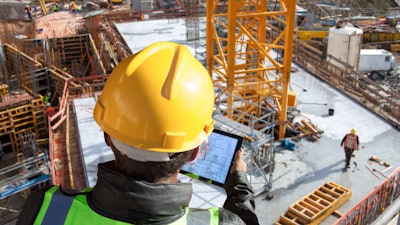
How we work has changed drastically over the last few years. Employees can work from nearly anywhere at any time – we have the evolution of mobile connectivity to thank for that. More than three-quarters of the world’s workforce is working somewhere beyond the confines of a desk. But it’s not just about enabling the mobility of traditional work; as it turns out, many employees in the concrete construction industry are increasingly relying on mobile technology to execute their jobs, as the construction industry faces mounting pressure to keep pace with digital transformation. As a result, contractors must empower a more connected workforce.
It's important to first acknowledge that portable devices and mobile ones are two different branches of the same tree. Mobile devices certainly lend themselves to being portable, but portable devices – think of technology like laptop computers – don’t necessarily lend themselves to true mobility.
In the past, construction workers may have had access to laptops, and while portable, they do not have the same degree of portability as a smartphone or tablet. Given the ways portable devices are used, they require management strategies that focus more on securing the device and what’s on it rather than accounting for what the worker is doing while using it. Workers who are actively using a portable device, however, are most likely seated and physically safe – not working around or operating heavy machinery.
With construction workers able to access the digital tools they need from a hand-held device that connects to the internet anywhere, workers are more likely to use the device while moving or trying to complete multiple tasks. This can pose a safety risk for the worker and their peers.
Understanding The Difference
It’s important to understand the distinct differences between mobility and portability. The best way to make this distinction is with one word: size. Portable and mobile are two terms with differing implications often used to describe various subsets of connected devices – while mobile devices and portable devices can both move from place to place, the form factor of mobile devices enables people to use them while they are physically moving or working on other tasks. In the context of the concrete construction arena, mobile devices enable workers to remain connected to digital workflows without having to go find a place to use their laptops and connect to the internet in less than ideal conditions.
| Mobility | Portability |
| The device's form factor promotes its use in nearly any environment, regardless of location, proximity, movement, etc. | The device’s form factor limits its use to stationary sessions |
| User centric | Device centric |
Weighing The Benefits & Risks
There’s certainly value in empowering connectivity at all times and places, and while the benefits are plenty, there are some risks to remain aware of.
The biggest benefit of a mobile device is that it can be used anytime and anywhere. With that mobility, employees get real-time access to information every second of the day. Smartphones and tablets have created an opportunity for those not confined to their desk to work digitally, and companies are subsequently pursuing ways to digitize many workflows through mobile apps.
Now - let’s talk about some of the pitfalls of mobility. With smartphones having no limitations to useability, there comes an increasingly complicated set of safety risks, both on and off the clock. There might be little room for interpreting how mobile devices should be used, if at all, depending on contextual factors such as location, movement, or time of day. Whether an employee is driving between jobs, walking across scaffolding, or operating dangerous machinery, being distracted by a device can put that worker and others at risk. Contractors are obligated to ensure the safety of their employees while using mobile devices.
Mobile Device Management
There are still so many employers who implement mobile device management (MDM) through the lens of portability, even though we’ve witnessed mobility evolve rapidly. The problem is that traditional MDM pays little mind to how the device is being used and focuses primarily on the device and its network security. For the past few years, almost everything that can be done on a laptop can also be done on a smartphone. Because of that, mobile devices must be able to support specific business groups, departments, and work roles across various situations and environments.
Construction managers must ensure MDM and usage policies are focused on creating a space for efficient and productive mobile device usage for every job across the business. Another concern that surfaces when deploying traditional MDM solutions is that even though they help to enforce policies, the creation of user personas is fairly static, and based on a user’s role rather than having the ability to dynamically adapt based on a user’s location, what they are doing, when they are doing it, or other contextual elements.
Tailoring Mobile Devices To Context
All of the issues above pose significant questions as to how contractors and business leaders can minimize the risks of mobility for their employees, one of the most important being: How can construction managers implement strategies to manage flexible device use while still ensuring their employees have access to content and applications when it’s safe and secure to do so?
By adding a layer of context to mobility management strategies, contractors can keep workers safe while driving mobile enablement. By using contextual triggers within contextual mobility management (CMM) software, workers can use the applications they need when they need them. Construction employees are rarely confined to one area, and CMM recognizes that. As the worker’s context changes, so do the mobile permissions – automatically and synchronously.
Ensuring Safety & Security
With mobility management software and a rational mobile device policy that considers the context of construction workers’ roles, contractors can strategically manage the usage of mobile devices while bolstering productivity and safety. Implementing CMM can dynamically and automatically adapt access to mobility, resulting in a proactive approach to safety that allows for simple enforcement. Contractors can create a safe and secure environment by providing employees a balance between connectivity and productivity while enabling mobility across their construction workforce.



















